General Apple and Mac desktop news is covered in Mac News Review. iPad, iPod, iPhone, and
Apple TV news is covered in iOS News
Review. All prices are in US dollars unless otherwise noted.
News & Opinion
Reviews
Apple Updates
Products & Services
Software
News & Opinion
How Did the Retina MacBook Pro Get a Gold-Level
EPEAT Rating?
Fortune's Philip Elmer-DeWitt addresses a question that's certainly
been perplexing me since Apple's bust-up with EPEAT was reconciled last
Friday with complimentary announcements that "all eligible Apple
products" were back on the Green Electronics Council's registry - giving them the Gold label that
indicates they are approved for purchase by schools and government
agencies that are required to buy only EPEAT-approved computers.
It was also announced that all four models of its new MacBook Pro with Retina
Display, a machine whose batteries are glued to the aluminum
chassis with an industrial adhesive so powerful that it has been proved
impossible in teardowns to remove them without rupturing their
integrity and "leaking hazardous goo all over" (as iFixit put it) have
been awarded EPEAT Gold labels.
Say what?
Elmer-DeWitt cites The Electronics TakeBack Coalition's National
Coordinator Barbara Kyle
commenting:
"While we are very glad to see that Apple has rejoined the EPEAT
program, we are astonished to see that in reposting its products to the
EPEAT registry, Apple has actually listed four versions of the Mac Book
Pro with Retina as EPEAT Gold level products. We seriously doubt
that these MacBooks should qualify for EPEAT at any level, because we
think they flunk two required criteria in the 'Design for End of Life'
section of the standard. They are:
- Criterion 4.3.1.3: External enclosures shall be easily removable
by one person alone with commonly available tools.
While you
can open up the enclosure, you can't completely remove one half of the
casing from the large group of batteries. They are glued to the case
with industrial strength glue.
- Criterion 4.3.1.5: Identification and removal of components
containing hazardous materials.
This criteri[on] specifically
applies to batteries, as well as circuit boards over 10 cm2
and other components, and says they must be safely and easily
removable. Gluing the battery in does not quality as 'easily
removable.' In fact, it's exactly the kind of design that this standard
seeks to discourage."
So how did the Apple's Retina MacBooks get Gold label ratings?
Ms. Kyle further explains:
"It's important to understand that the manufacturers grade
themselves against the EPEAT criteria first, and then EPEAT conducts a
review of this grading. That EPEAT review has not yet occurred. They
can require the manufacturers to remove any product from the registry
if it is not found to conform to the IEEE standard.
"Apple is often a design leader in electronics, but they really blew
it here. They are ignoring a really important design goal here -
designing to promote product longevity and reuse. Designers should make
it as easy as possible for users to replace their own batteries. This
is like designing a car with tires that you can't replace when you have
a flat without making an appointment at the dealer and paying them a
hefty fee for the tire."
Ergo, at least if the EPEAT system has any integrity, we should be
able to expect that the MacBook Pro with Retina Display's presumptuous
Gold label rating will be downgraded without delay. I try to be wary
and skeptical regarding conspiracy theories, but it's hard not to
wonder if there were any under-the-table quid pro quos associated with
Apple's return to the EPEAT fold.
Link:
How Did the New MacBook Pros Get Gold-Level Green Ratings?
MacBook Pro Retina Display 'a Solution in Search of
a Problem'
ReadWriteWeb's Antone Gonsalves contends that only Apple could get
away with charging a $400 premium for a feature that no one needs, that
few people will notice, that doesn't work with most apps, and that was
not on anyone's wish list until the company announced it last
month.
He's talking about the 2880 x 1800 resolution Retina Display in
Apple's newest MacBook Pro model, noting that while Retina-grade
ultrahigh-resolution may be a valuable innovation on the iPhone and
iPad, it's a solution in search of a problem on the MacBook Pro, and
that until Apple unveiled the new machine at its Worldwide Developers
Conference (WWDC) in June, no one thought the resolution on current
MacBook Pros was insufficient.
Gonsalves acknowledges that Apple has shown the ability to turn new
features into virtual must-haves, even if they're not really needed,
and suggests that strategically Apple's ploy is to use the new MacBook
Pro to set a standard for quality that people will demand from other PC
makers, which would have Apple sitting pretty with its long-term
contracts with manufacturers of high-resolution screens. He observes
that while that's a good plan for Apple, most consumers would be better
off waiting until the Retina technology becomes less expensive and
better able to actually deliver a higher-quality experience in
real-world applications.
Publisher's note: Gonsalves must not have much of a short-term
memory, as a Retina Display was one of the most popular guesses for
features on the 2012 MacBook Pro update. It's also a bit disingenuous
to claim that it "doesn't work with most apps" when in fact it does -
it just doesn't give them the doubled Retina resolution. (It's like
saying your HD TV doesn't work with standard definition content because
it doesn't display is in high definition.) Most apps will have to be
updated for that, and several already have. dk
Link: Apple's Brilliant
Boondoggle: MacBook Pro Retina Display
Retina MacBook Pro Display Glitches when
Waking
The Register's Anna Leach says that reports are cropping up on
support forums about problems encountered when Apple's new MacBook Pro
with Retina Display is woken from sleep, upon which on affected
machines the operating system's user-interface redraw process
completely collapses, scribbling bits of open windows and phantom
fragments of closed ones all over the screen. Others are reporting that
animations and graphics, such as scrolling, gets choppy and sometimes
freezes up entirely.
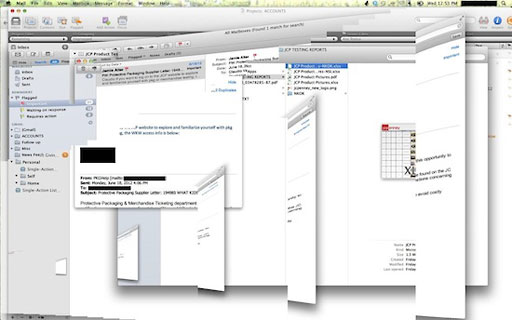
Example of the Retina Display glitch.
A software issue in support for the MacBook Pro's automatic
switching between the onboard Nvidia and Intel graphics chipsets is
suspected as a possible cause, and it's noted that the problem seems to
only affect users with Mac OS X Lion, with Mountain Lion developer's
preview users saying they've not experienced the anomalous
behavior.
Link: Sleek New Macs
Violate Fanbois' Retinas with Display Garbage
Apple Thunderbolt Display Plagued by Noise with New
MacBook Air
Electronista reports that some users of Apple's Thunderbolt Display
and the new 2012 MacBook Air
line are finding that after a few hours' use, the display's
speakers distort, crackle, and emit a static noise. The article says
that thus far there are no permanent solutions. Temporary workarounds
including disconnecting the Thunderbolt cable and replugging or
changing output methods away from and back to the display's
speakers.
Link: Apple Thunderbolt
Display and MacBook Air Plagued by Noise
Setting Up a Beater Mac Notebook for Under
$300
AppStorm's Adam Williams observes that Macs are expensive, making
Apple laptops especially so when used in road-warrioring mode -
thief-magnets that are also liable to being dropped or lost. As a
freelance writer, Williams says he needs a real computer for
significant work when he travels that he can lug around, collecting
accidental knocks without worry, as well as a Mac that can act as
temporary backup if his MacBook Pro ever needs repair. In short, an
older, expendable Mac that doesn't need worrying about.
Alternatives he considered are:
- MacBook Air - too expensive and potent thief-bait
- Netbook - portability and weight advantage offset by a small screen
and cramped keyboard, and he'd like to remain in the OS X environment
if possible.
- Hackintosh - needs lot of tedious hacking to get up and running,
making it less expendable
An iBook G4 turned out to be Williams' choice for a cheap but
capable beater Mac, obtainable for no more than $150 and not taking too
much time to get up and running. Anything older than an iBook G4, he
says, and it won't run OS X
10.4 Tiger or 10.5 Leopard
very effectively; any more powerful, and it starts to get too expensive
to be an expendable Mac.
Williams snagged an immaculate 1 GHz iBook G4 for just over
$100. He recommends upgrading system memory to at least 1 GB and
making sure you have an AirPort wireless card installed. He also makes
several software suggestions. As a longtime Mac user says he is very
pleased with his iBook, finding that using Tiger no hardship at
all.
Link: Setting Up an
Awesome Beater Mac for Less than $300
Tips for Buying a Used MacBook
MacFixIt's Topher Kessler says if you're planning on purchasing a
used MacBook, MacBook Pro, or MacBook Air, he recommends that you
thoroughly test it to ensure it works properly, noting that while new
and Apple Certified Refurbished Mac systems come with a one-year
warranty and 90-days of free technical support, that will likely will
not be the case with a used system, so it's due diligence to ensure
that your prospective purchase is working properly. Kessler outlines
several things you can do to determine that the system is working well
and does not need repair.
He also advises making sure the system comes with its recovery DVDs
(the gray discs that were shipped with the system), a vitally important
point that many overlook when purchasing used. These discs are crucial
to being able to test and restore the computer's operating system
should that become necessary.
Kessler suggests a kit of tools and test software to take along for
vetting your prospect MacBook Pro in order to test most of the system's
functions properly and check it for problems, and explains how to
proceed.
Link: Tips and Checks
When Buying a Used MacBook
Reviews
AnandTech: 2012 MacBook Air a Reasonable Upgrade
from Older MacBook Pros
AnandTech's Anand Lal Shimpi says that Apple laptop
characterizations are becoming confused, with the MacBook Pro having
once stood for tons of power plus upgradability - but with the new
Retina Display model it's now just tons of power, the Retina Pro
machine now essentially a thicker, faster MacBook Air.
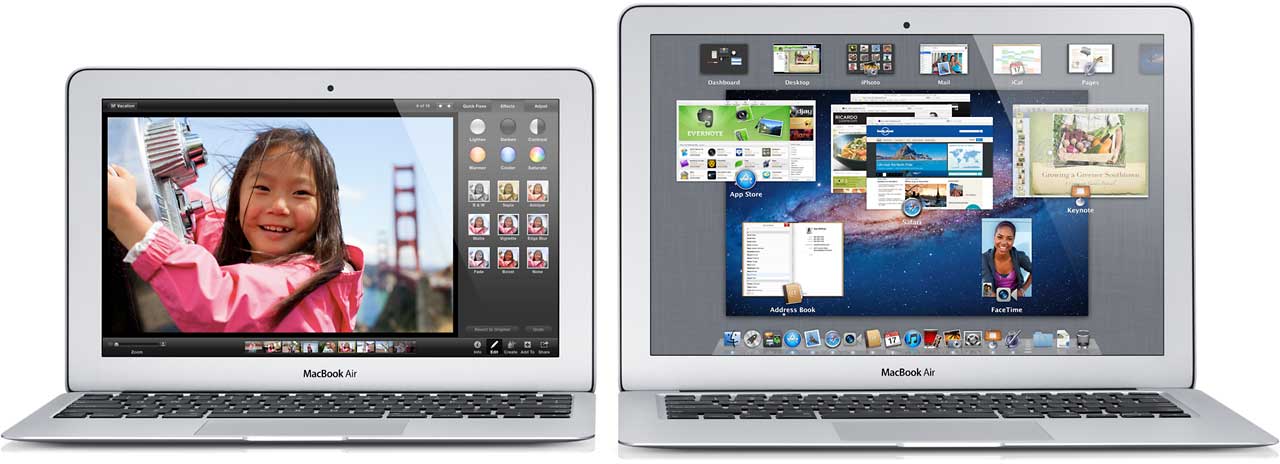
11" and 13" 2012 MacBook Airs.
Lal Shimpi notes that MacBook Air doesn't help in the clarity
department, since you can now order an Air with up to 8 GB of RAM
and a 512 GB SSD, so users who were once forced into Pro territory
because of RAM and storage requirements can now happily live with an
Air, and the Air is now more affordable as well. While the 11" model still starts at
$999, the 13" version
is now only $200 more, while getting Ivy Bridge, USB 3.0, and faster
SSD.
He observes that the 11" MacBook Air is a great option for those who
want the portability of a tablet but find themselves wanting to attach
a keyboard to it most of the time, its 11.6" display boasting the
highest pixel density of all of Apple's non-Retina displays at 1366 x
768, and with Thunderbolt, the 11" MacBook Air can give you the best of
both worlds: an incredibly portable computer when you're on the go,
with enough power to serve as your desktop Mac when docked to a
Thunderbolt Display. However, Lal Shimpi says if couldn't have more
than one system, he'd opt for the 13" MacBook Air.
He comments that thanks to architectural, frequency, and thermal
improvements, one of the cores from a 2012 MacBook Air ends up being
faster than both cores in a 2010 MBA. Stated another way, the
2012 models end up being more than twice as fast as the 2010 models in
many CPU tests, and battery life has also improved thanks to Intel's
22nm silicon. And by offering 8 GB RAM and 512 GB SSD options,
Apple has made the MacBook Air a reasonable upgrade for owners of older
MacBook Pros.
Link: The 2012 MacBook
Air (11 & 13-inch) Review
13" MacBook Air Is the Perfect Ultrabook
VentureBeat's James Pikover says that generally considered the
premier Ultrabook (though its not officially labeled one), the MacBook
Air remains the thinnest and lightest 13" and 11" Ultrabook, offering a
near-perfect balance of size and power, and what's remarkable about the
2012 model is that it drops the price by $100 and offers the updated i5
or i7 at faster clock speeds while also doubling the RAM to 8 GB,
so for less money, "this year's stock MacBook Air outperforms last
year's high-end model by 150%* for nearly every application."
Unfortunately he also reports that running certain
processor-intensive tasks the 2011 models fan will scream and the left
side of the keyboard heat up to around 100F while on the 2012 MBA the
same thing can happen, but it rarely does thanks to the improved
performance of Intel's Ivy Bridge processors which make it nearly
impossible to stress the Air to that point in normal use, and battery
life is greatly improved too.
* Publisher's note: Geekbench scores
show a much more modest 22% improvement in CPU performance - this
year's 2.0 GHz i7 model vs. last year's 1.8 GHz i7 version, which is
coincidentally a 22% difference in CPU clock speed.
Macworld Labs reports an overall 41% improvement when comparing the
2.0 GHz 13" MBA to last year's 1.7 GHz model. While the SSD is twice as
fast, nowhere do I find anyone reporting even 50% better overall
performance, let alone the 150% Pikover claims, and claiming that this
year's stock 1.7 or 1.8 GHz MBA outperforms last year's top-end 1.8 GHz
i7 models by 150% is simply preposterous. Mr. Pikover needs to relearn
his basic math skills. dk
Link: Apple's
MacBook Air 13": The Perfect Ultrabook
13" Mid 2012 MacBook Air from a Windows User's
Perspective
TechSpot's Shawn Knight notes that while the new MacBook Pro with
Retina Display has been hogging most of the press attention, the 2012
MacBook Air has been upgraded with Intel Ivy Bridge processors sporting
HD 4000 graphics, higher capacity storage and memory options, an
improved 720p FaceTime HD camera, and support for USB 3, with the
13" model also receiving a $100 price cut, now starting at $1,199.
Knight approaches the MacBook Air as a strictly Windows user, noting
that the setup process for a new user isn't much different than you'd
find on a Windows machine, and that one of the great things about
working on a Mac is that only one company sells it, and Apple doesn't
load the Mac down with licensed bloatware designed to further line its
pockets and cause headaches to the end user.
Knight summarizes that four years after its unveiling, the Air is
still one of the sexiest notebooks on the market, and with the recent
slight price adjustment, it seems to be competing well on value
terms.
Link: Apple MacBook Air 13"
Mid-2012 Review
Expert Reviews: 13" MacBook Air Gets a Welcome
Performance Boost
Expert Reviews' Tom Morgan notes that Apple might have the smaller
ultraportable market all but sewn up with the 11" MacBook Air, but
there are far more alternatives once screen size jumps up to 13", with
the latest 13" MacBook Air having been upgraded with Intel Ivy Bridge
processors and Thunderbolt technology plus USB 3.
Morgan observes that if you're already familiar with the MacBook
Air, it could be difficult to spot the differences between the existing
model and this new version, but Apple has reduced the size of the
MagSafe adapter and replaced the old USB ports with faster USB 3
variants, although it hasn't colored them blue to avoid spoiling the
generic gray look its been using for the past five years. It also has a
Thunderbolt port instead of a Mini DisplayPort connector.
The old Sandy Bridge processor has been replaced with one of Intel's
latest low-voltage Ivy Bridge chips, and Apple has also upgraded the
old 3 Gbps SATA Revision 2 SSD with a faster 6 Gbps SATA
Revision 3 model, which should help reduce boot and application loading
times, as well as speed up file transfers. Intel's HD 4000 integrated
graphics are a welcome step up from the previous generation, and
despite receiving a significant performance upgrade, Apple has managed
to keep the Air's battery life at the same level as last year's
model.
Link: Apple 13-inch
MacBook Air (2012) Review
13" MacBook Pro Resting on Its Laurels?
The Register's Stephen Dean notes that while the latest MacBook Pro
with Retina Display may be setting a new standard at the top of the
range, a modest update for the standard 13" MacBook Pro looks
a bit like Apple resting on its laurels with the older design, although
he acknowledges that its got some pretty good laurels to start off
with.
While the aluminum unibody design may be essentially unchanged in
nearly four years, Dean praises it as still one of the smartest, most
attractive 13' laptops on the market, with a build quality that "makes
most of its rivals look like a lump of Lego."
Link: Apple MacBook Pro
13in
AnandTech: 2012 MacBook Pro the Last Classic Mac
Laptop?
AnandTech's Vivek Gowri notes that with most of the attention from
Apple's hardware refresh event centered around iOS 6 and the new
Retina MacBook Pro, the updated 2012 edition of the regular MacBook Pro
(MBP) has been flying a little bit under the radar, being essentially
just an Ivy Bridge-infused version of the venerable unibody MacBook Pro
chassis that we've known and loved for the last few years.
x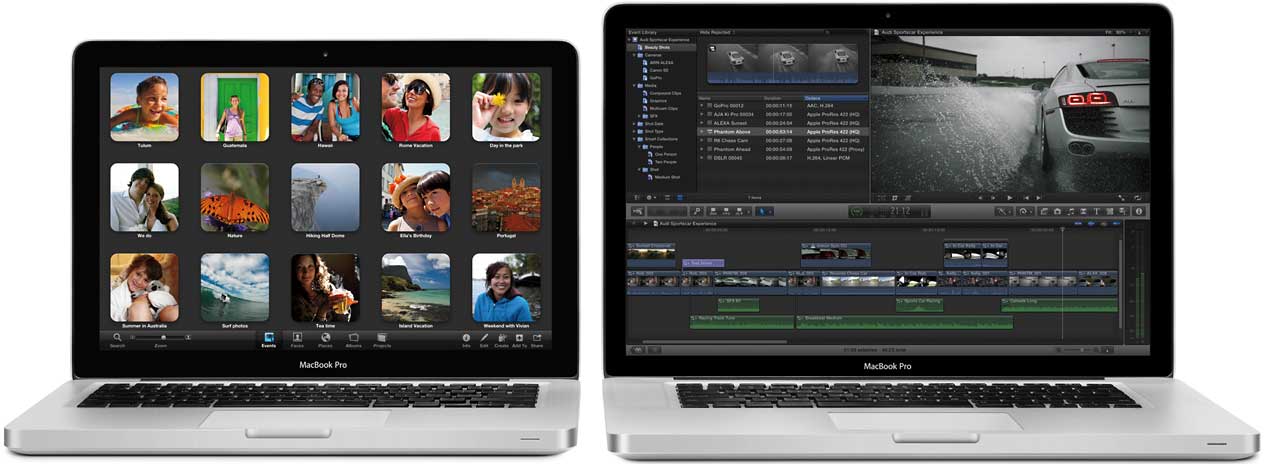
13" and 15" 2012 MacBook Pros.
The 13" model retains a dual-core processor and integrated graphics
only (albeit upgraded to Intel's latest HD 4000 graphics), while
the 15" unit
makes the switch from AMD to Nvidia's new Kepler-based GT 650M
dedicated graphics, and USB 3.0 is now supported across the board, plus
there's a free update to OS X 10.8 Mountain Lion when
it releases later this month.
Gowri deduces reasonably that this revision is likely to be the last
iteration of the original unibody MBP, which will have had a roughly
4.5 year run as one of the most instantly recognizable notebook
computers on the market by the time it's discontinued - a great
notebook and a very solid and well-engineered portable system, the
latest and last in a line of standard-setting notebooks that helped
shape the direction of the notebook industry over the last five years -
but at this point, an aging design retaining features that are starting
to matter less and less.
Link: The 2012 MacBook
Pro Review
Apple Updates
MacBook Air and MacBook Pro Update 1.0 for 2012
Models
This update fixes an issue that can lead to increased CPU power
consumption, and it improves compatibility with some USB devices.
This update is recommended for all Mac notebooks introduced since
June 2012.
Link: MacBook Air and
MacBook Pro Update 1.0
Tech Trends
Ultrabook Numbers Not Good
Cnet's Brooke Crothers reports that Apple continues to fend off the
Ultrabook challenge, with shipments of the thin-and- light Windows
laptops significantly below what Intel had hoped for while Apple's
MacBook Air continues to
coast enjoying continued popularity, according to IDC analyst Jay Chou,
who told Cnet that "The [Ultrabook] volume isn't there, and it's going
to be way below what Intel had hoped for." Intel had projected at the
beginning of the year that Ultrabooks could take 40% of the consumer
laptop market.
Mr. Chou thinks PC vendors might move a million Ultrabooks this year
out of a total of about 225 million laptops IDC estimates will ship by
the end of 2012, accounting for a proverbial sip-in-the-ocean, while
Apple sold about 2.8 million MacBooks in its most recent reported
quarter, up slightly from 2.75 million in the same quarter last
year.
Link: MacBook Win,
Ultrabook Fail: Numbers Not Good, Says Analyst
MacBooks Outselling Ultrabooks 10:1
Smarthouse's David Richards notes that the roughly 500,000
Ultrabooks that were shipped in the first half of 2012 falls woefully
short of chipmaker Intel's aggressive targets for the thin-and-light
notebooks, having projected at the beginning of the year that
Ultrabooks could take 40% of the consumer laptop market. Richards
observes that even if PC vendors manage to sell one million units for
the full year, that would only represent about 0.4% of the 225 million
laptops that IDC predicts will be sold during the year.
Meanwhile Apple's MacBook Air, which obviously inspired the
Ultrabook initiative, continues to dominate the sector.
Link: Apple MacBook
Outselling Ultrabooks 10-1
DigiTimes: Global Notebook Shipments to Enjoy 5% Growth in
2Q12
DigiTimes Research's Joanne Chien reports that global notebook
shipments, facing overstocked inventory in March and a weakening
worldwide economy starting in May, only achieved sequential growth of
5% in the second quarter, and compared to the same period a year ago,
volume dropped 1.8%, reaching only slightly greater than 50 million
units, according to DigiTimes Research findings.
However, sales performance was uneven. Asustek Computer charged
ahead with sequential shipment growth of 36% in the quarter, while
Hewlett-Packard (HP), Dell, and Toshiba all suffered on-quarter drops
of 4-7%, and Acer, benefiting from its netbook shipments and pricing
strategy, managed close to the notebook market average, as did
Lenovo.
Chien notes that HP's rank as the number one vendor is on the
bubble, with its shipment gap over Lenovo in the quarter less 500,000
units, while Asustek's market share of 11.3% helped the company
overtake and pass Dell to become the fourth-largest vendor worldwide.
Apple and Samsung Electronics ranked seventh and eighth respectively in
global sales, trailing closely behind Toshiba in sixth place with a gap
of less than 2%.
Link: Global Notebook
Shipments to Enjoy 5% Growth in 2Q12 - Asustek Gains; Apple in 7th
Place Globally (subscription required)
Products & Services
Seagate Backup Plus Portable Drive for Mac an
Ideal MacBook Air Companion
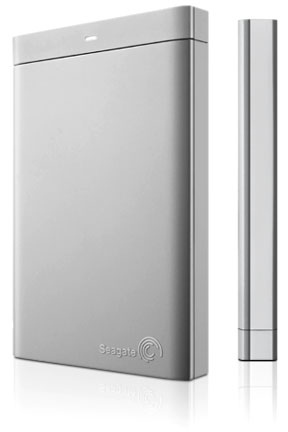 PR: The Backup Plus portable drive for Mac
from Seagate is a good solution to the problem of limited affordable
storage capacity with MacBook Airs, the base model MacBook Pro with
Retina Display and other SSD-equipped laptops, with the option of
increasing transfer speeds by upgrading to Thunderbolt technology.
PR: The Backup Plus portable drive for Mac
from Seagate is a good solution to the problem of limited affordable
storage capacity with MacBook Airs, the base model MacBook Pro with
Retina Display and other SSD-equipped laptops, with the option of
increasing transfer speeds by upgrading to Thunderbolt technology.
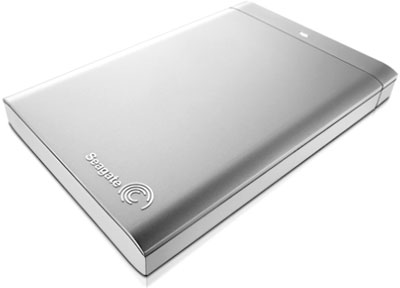 Backup Plus is Time Machine ready for making easy,
automatic backups of your Mac. Since it is Mac formatted out of the
box, simply plug it in, set it, and forget it. It is USB bus-powered so
it requires no external power source and can be upgraded to Thunderbolt
technology, FireWire 800, or USB 3.0 with optional add-on adapters.
Backup Plus is Time Machine ready for making easy,
automatic backups of your Mac. Since it is Mac formatted out of the
box, simply plug it in, set it, and forget it. It is USB bus-powered so
it requires no external power source and can be upgraded to Thunderbolt
technology, FireWire 800, or USB 3.0 with optional add-on adapters.
System Requirements
- Mac OS X 10.6 or higher, or Windows 7, Windows Vista, Windows XP
SP3 (32-bit and 64-bit)
- USB 2.0 port
The Backup Plus is available in 1 TB and 500 GB capacities
starting at $119.99
Link: Seagate Backup
Plus Portable Drive for Mac (Seagate
Backup Plus drives and accessories are available at Amazon.com)
Software
Upcoming Pixelmator 2.1 Optimized for MacBook Pro
Retina Display
PR: The ever-busy Pixelmator Team is about to release a new
major version of Pixelmator: Pixelmator 2.1, codenamed Cherry,
revealing that its "least secret feature" will be complete support for
the new Retina display on the MacBook Pro.
Pixelmator 2.1 Cherry is already fully Retina-ready, including all
of the user interface elements as well as the image editing engine
itself.
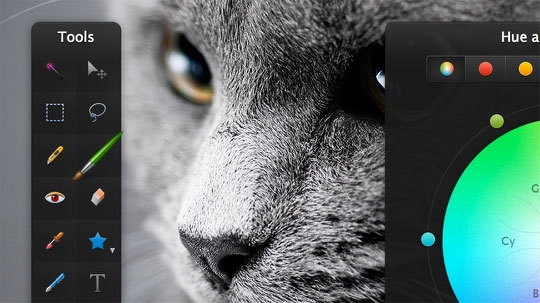
Pixelmator 2.1 gains Retina Display support.
Pixelmator developer Saulius Dailide says the new MacBook Pro with
Retina display (they've got a few around the office) looks totally
incredible, and is a brilliant fit for image editing using Pixelmator.
Dailide says they're also impressed by the MacBook Pro's speed and
power, HD graphics and video support, beautiful looks, and many other
great features, declaring that Apple did a phenomenal job on the new
MacBook Pro, which he contends is very likely the best Mac that has
ever been made, and surely the best laptop on the planet.
You can check out a preview video of Pixelmator 2.1 Cherry on the
Retina MacBook Pro.
Publisher's note: Pixelmator 2.1 will probably be a free upgrade
from version 2.0.x, which is currently on sale in the Mac App Store for
half it's regular $29.99 price. No idea if it will return to this price
when 2.1 arrives. dk
Link: Least Secret
Feature in Upcoming Pixelmator 2.1 Cherry
Link: Pixelmator, currently $14.99 at
the Mac App Store
Bargain 'Books
For deals on current and discontinued 'Books, see our 13" MacBook and MacBook Pro,
MacBook Air, 13" MacBook Pro, 15" MacBook Pro, 17" MacBook Pro, 12" PowerBook G4, 15" PowerBook G4, 17" PowerBook G4, titanium PowerBook G4,
iBook G4, PowerBook G3, and iBook G3 deals.
We also track iPad,
iPhone, iPod touch, iPod classic, iPod nano, and iPod shuffle deals.




 PR: The Backup Plus portable drive for Mac
from Seagate is a good solution to the problem of limited affordable
storage capacity with MacBook Airs, the base model MacBook Pro with
Retina Display and other SSD-equipped laptops, with the option of
increasing transfer speeds by upgrading to Thunderbolt technology.
PR: The Backup Plus portable drive for Mac
from Seagate is a good solution to the problem of limited affordable
storage capacity with MacBook Airs, the base model MacBook Pro with
Retina Display and other SSD-equipped laptops, with the option of
increasing transfer speeds by upgrading to Thunderbolt technology. Backup Plus is Time Machine ready for making easy,
automatic backups of your Mac. Since it is Mac formatted out of the
box, simply plug it in, set it, and forget it. It is USB bus-powered so
it requires no external power source and can be upgraded to Thunderbolt
technology, FireWire 800, or USB 3.0 with optional add-on adapters.
Backup Plus is Time Machine ready for making easy,
automatic backups of your Mac. Since it is Mac formatted out of the
box, simply plug it in, set it, and forget it. It is USB bus-powered so
it requires no external power source and can be upgraded to Thunderbolt
technology, FireWire 800, or USB 3.0 with optional add-on adapters.
